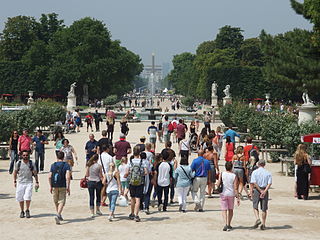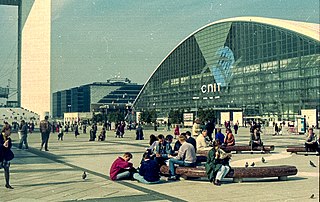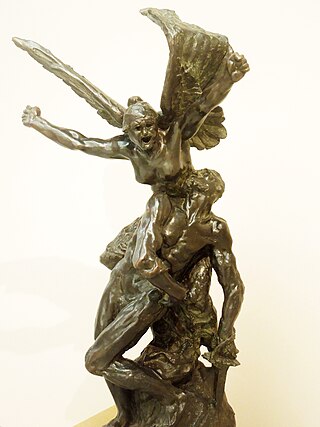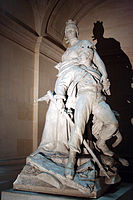
Frédéric Auguste Bartholdi was a French sculptor and painter. He is best known for designing Liberty Enlightening the World, commonly known as the Statue of Liberty.

La Défense is a major business district in France's Paris metropolitan area, 3 kilometres (1.9 mi) west of the city limits. It is located in Île-de-France region's department of Hauts-de-Seine in the communes of Courbevoie, La Garenne-Colombes, Nanterre, and Puteaux.

The Tuileries Garden is a public garden between the Louvre and the Place de la Concorde in the 1st arrondissement of Paris, France. Created by Catherine de' Medici as the garden of the Tuileries Palace in 1564, it was opened to the public in 1667 and became a public park after the French Revolution. Since the 19th century, it has been a place for Parisians to celebrate, meet, stroll and relax. During the 2024 Summer Olympics and Paralympics, it was the site of the Olympic and Paralympic cauldron.

Esplanade de La Défense is a station on Paris Métro Line 1 on the outskirts of La Défense on the border of Courbevoie and Puteaux. It has an island platform because of limitations on space due it being enclosed in a site originally earmarked for one of the underpasses of the A14 autoroute.

Pont de Neuilly is a station on Paris Métro Line 1, situated in the prosperous suburban commune of Neuilly-sur-Seine. Between 1940 and 1950 it was known as Pont de Neuilly, Avenue de Madrid.

Puteaux is a commune in the western suburbs of Paris, France. It is located in the heart of the Hauts-de-Seine department, 8.7 kilometres (5.4 mi) from the centre of Paris.

The Centre of New Industries and Technologies, located in Puteaux, France, was the first building developed in La Défense, west of Paris, France. It functions as a convention centre, though it also houses shops and offices such as Fnac, ESSEC Business School campus for executive education, as well as a Hilton hotel.

The Hôtel de Ville is the city hall of Paris, France, standing on the Place de l'Hôtel-de-Ville – Esplanade de la Libération in the 4th arrondissement. The south wing was originally constructed by Francis I beginning in 1535 until 1551. The north wing was built by Henry IV and Louis XIII between 1605 and 1628. It was burned by the Paris Commune, along with all the city archives that it contained, during the Semaine Sanglante, the Commune's final days, in May 1871. The outside was rebuilt following the original design, but larger, between 1874 and 1882, while the inside was considerably modified. It has been the headquarters of the municipality of Paris since 1357. It serves multiple functions, housing the local government council, since 1977 the Mayors of Paris and their cabinets, and also serves as a venue for large receptions. It was designated a monument historique by the French government in 1975.

Louis-Ernest Barrias was a French sculptor of the Beaux-Arts school. In 1865 Barrias won the Prix de Rome for study at the French Academy in Rome.

The Église de la Sainte-Trinité is a Roman Catholic church located on the place d'Estienne d'Orves, at 3 rue de la Trinité, in the 9th arrondissement of Paris. It was built between 1861 and 1867 during the reign of Emperor Napoleon III, in the residential neighborhood of the Chaussée d'Antin. It is in the ornate Neo-Renaissance or Second Empire Style, with a highly visible 65-meter-tall belfry.

The Pont de Neuilly is a road and rail bridge carrying the Route nationale 13 (N13) and Paris Métro Line 1 which crosses the Seine between the right bank of Neuilly-sur-Seine and Courbevoie and Puteaux on the left bank in the department of Hauts-de-Seine. It faces the headquarters of La Défense and is aligned on the Axe historique of Paris.

Charles Marie Émile Seurre or Seurre the Younger was a French sculptor.
Pierre Marie François Ogé was a French sculptor born in Saint-Brieuc on 24 March 1849 and who died in Paris on 5 June 1913.
Adrien Étienne Gaudez was a French sculptor who worked in the 19th century. He produced several monumental figures that were cast in bronze. Gaudez studied sculpture under the tutelage of Francois Jouffroy at the École des Beaux-Arts and in 1870 was a prisoner of war during the Franco-Prussian War.

Onésime-Aristide Croisy was a French sculptor. He is known for his dramatic bronze military statues, but perhaps best known for his marble Le Nid, showing two children asleep in an armchair.

La Defense, also known as The Call to Arms, is a sculpture by Auguste Rodin.

Suzon is an early bust of a woman by Auguste Rodin, created between 1872 and 1873 when he wholly worked on commissions. It was inspired by late 18th century Romantic works whilst Rodin was in exile in Brussels due to the Franco-Prussian War. He created it in homage to Albert-Ernest Carrier-Belleuse, another sculptor also in exile there who was highly influential on Rodin's early works.





















